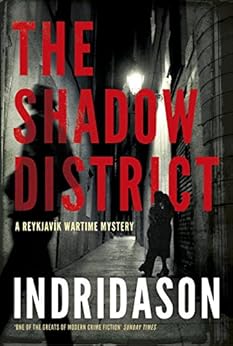Having read
and enjoyed all of Indriðason’s Detective Erlendur books, I
was anxious to read this first of a new series of historical crime novels set
in Iceland during World War II.
In 1944,
the semi-clad body of a young woman is found behind the National Theatre in
Reykjavík. Flóvent, an Icelandic
detective with Reykjavík’s fledgling Criminal Investigation
Department, and Thorson, an Icelandic-Canadian seconded to the American
military police, collaborate to identify the victim and the killer. In the present, Konrád, a retired
police detective, helps look into the death of Stefán Thordarson
whose personal possessions include newspaper clippings about the wartime
murder.
I did not
find that this book measures up to the quality of the Erlendur books. The slow pace of this police procedural was
frustrating at times. The dialogue was
stilted. And there were too many clichés: “She nearly jumped out of her skin” and “He
nearly jumped out of his skin” and “chatted to her about everything under the
sun”.
Perhaps
these latter are a product of poor translation, but there are other weaknesses
as well. For instance, the links between
the wartime murder and Konrád’s childhood seem too
coincidental. Then there’s the
introduction, very late in the novel, of the point of view of Thordarson to
explain the last few days of his life.
This technique seems like the author taking an easy way out.
One of the
aspects I most enjoyed is the novel’s touches on Icelandic history and
culture. I learned, for example, about
the Situation, the liaisons between soldiers and Icelandic women; I had never
considered the impact of tens of thousands of servicemen pouring into a city
with a population of only 40,000. The
references to Icelandic folklore, especially the huldufólk or hidden people, are interesting.
The independence
of Iceland was also something I had known nothing about: at Þingvellir on June 17, 1944, when Iceland
was occupied by the Allies and Denmark was occupied by the Nazis, Iceland unilaterally
declared independence from Denmark.
(Having recently visited Þingvellir, where the Alþingi, the world’s
first parliament, was founded in 930 and where the Icelandic nation agreed to
adopt Christianity in the year 1000, I understand why Icelanders chose this
site for its declaration of independence and why the site is a national shrine.)
I’m not
sure where the Reykjavík Wartime mystery series goes from here. (Does it follow more of Flóvent’s cases
during the war? Unfortunately, I didn’t
find that the detective is developed in sufficient depth. Thorson had more interest for me but
primarily because of his Canadian roots in Manitoba and because the information
given about his personal life adds another dimension.) I’m also not sure I will revisit the series
when the next installment is released.

No comments:
Post a Comment